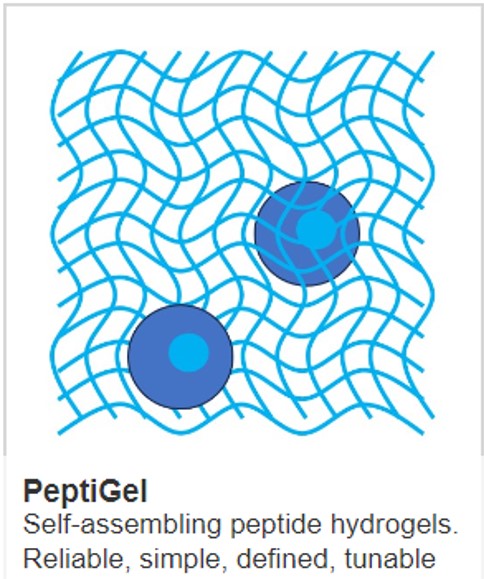Hydrogels for cell therapy

Cell therapy is an approach that is being used by many researchers to treat a variety of injuries and diseases. However, there are some challenges associated with it, such as the low rate of cell survival and the uncontrolled differentiation of the injected stem cells. But these are challenges that the use of hydrogels can potentially help to overcome.
What is cell therapy?
The human body contains over 200 different types of cells that carry out specific functions in order to keep the body healthy. Ageing, disease and injury can all affect these cells leading to them not being able to function as required.
Cell therapy is the introduction of new, viable cells into a patient’s body to replace the diseased or injured ones for therapeutic purposes.
Examples of cell therapy applications
The most frequently used type of cell therapy is bone marrow transplant (hematopoietic stem cell transplantation) which is used to treat a variety of blood cancers and hematologic conditions. A bone marrow transplant contains blood stem cells that the body uses to replenish the blood and immune system once they are transplanted into the patient. The success of many bone marrow transplants has led to researchers looking at other ways cell therapy can be used to treat patients.
Other applications of cell therapy include treating autoimmune diseases, cancer, infectious disease and urinary problems. Cell therapy also has the potential to help with improving weakened immune systems, patients with neurological disorders, rebuilding damaged cartilage in joints, and repairing spinal cord injuries.
Cell therapy tends to use stem cells, which can be modified by gene therapy first, in order, for example, to correct a mutation that is causing disease. Once this has been corrected, then the cells can be delivered to patients in order to repopulate the diseased areas of their body. This combination of gene and cell therapy allows for the development of therapies for blood disorders, such as severe combined immunodeficiency, some types of leukaemia and lymphoma.
Cell therapy classification
There are three different types of cell therapy used today, and these are:
- Allogeneic– Sometimes known as universal cell therapies, allogeneic cell therapy relies on a single source of cells to treat many patients. A donor sample is used to collect cells to make a Master Cell Bank (MCB) which is then used as a source to create cell populations that are processed according to the demands of the specific therapy.
- Autologous– Autologous cell therapy uses an individual’s cells, which are cultured and expanded outside the body, and then reintroduced back into the patient. The advantages of this approach to cell therapy include the minimisation of risks from bio-incompatibility, disease transmission and systemic immunological reactions.
- Xenogeneic– Xenogeneic cell therapy uses cells from a non-human source, such as pigs. Genetic engineering of pigs is being used to develop cells which are less likely to be rejected when transplanted to humans.
Types of cells used in cell therapy
There are three main types of cells used in cell therapy and they are:
- Stem Cells– These are the cells that all other cells with specialised functions are generated from. Stem cells can be divided to form more cells with a specific function, such as blood cells, bone cells, brain cells, or heart muscle cells. Stem cells are unique as there is no other cell in the human body that can generate new cell types
- Progenitor Cells – These cells are derived from stem cells and are then further differentiated to create specific cell types. However, each progenitor cell is only capable of differentiating into cells that belong to the same organ or tissue.
- Mature Cells– These are cells that have been differentiated already, so they have acquired a specific function rather than a generalised one.
The use of hydrogels in cell therapy
Biocompatibility is key in cell therapy as it deals with the ability of the implanted cells to function in vivo without eliciting detrimental responses in the body. In some cases, the body’s immune system can attack the implanted cells, causing them to be rejected, or the transplanted cells can attack the body’s existing cells.
Hydrogels have the ability to control cellular and molecular attachments with functional and structural integrity, allowing them to be used to create an environment that supports transplanted cells. This enables these cells to replace or restore the function of tissues that have been lost to disease or injury. Hydrogels can also be used as delivery vehicles for therapeutic genes that can be used to direct or enhance the function of the transplanted cells.
Why are peptide hydrogels particularly important in cell therapy?
We offer a diverse range of ready-to-use fully synthetic peptide hydrogels that are biologically relevant and formulated to meet your cells’ needs. Our PeptiGels are shear thinning and biocompatible, meaning they can be injected by application of shear stress (during injection) and will quickly self-heal after the removal of shear. Our PeptiGels can therefore be used to deliver biological cells and molecules during the injection process.
Other important aspects of PeptiGels that are useful in cell therapy are that they are non-animal derived matrices and lack immunogenicity.
IMAGE: BigStock



